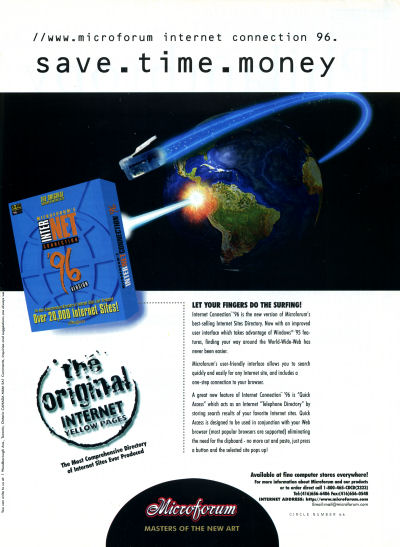Archive for the 'Computer History' Category
The VC&G Christmas Collection (2014 Edition)
Tuesday, December 9th, 2014
It’s that time of year again: the Yuletide. Over the past few years, I’ve been posting an annual collection of all the Christmas-related material I’ve written (both for this site and for others) into one place for easy reading. Below, you’ll find list of off-site Christmas slideshows, other features, and of course, plenty of Retro Scans of the Week.
I have a soft spot for Christmas, having been raised with the tradition, so this list is for me as much as it is for everyone else. After going through these things again, it’s amazing to see how much Christmas stuff I’ve posted over the years. I hope you enjoy it.
[ Continue reading The VC&G Christmas Collection (2014 Edition) » ]
[ Retro Scan of the Week ] Google in a Box
Monday, December 1st, 2014 “The Most Comprehensive Directory of Internet Sites Ever Produced”
“The Most Comprehensive Directory of Internet Sites Ever Produced”
18 years ago, a fairly complete index of the entire Internet — circa 1995 — could fit on a single CD-ROM — about 20,000 sites, as the box for Microforum’s Internet Connection ’96 says. [Update: See comments below for a discussion on the number of websites in 1995 and 1996] I ran a website back then, and the Web did indeed feel that small. FTP sites were still a big deal in those days, so that number may include them as well.
Today, some estimates say that the Web alone consists of over one billion websites. Consider storing a simple list of one billion websites URLs. If each URL was about 25 characters long (I’m just making this up as an example), it would take around 25 gigabytes to store the list alone (or about 39 CDs worth). Google stores that list and copies of individual websites for caching. Needless to say, that takes quite a bit more storage room.
So it’s amusing to think back to a time when you might actually buy a professionally mastered and duplicated CD-ROM containing web addresses, many of which were potentially obsolete by the time the disc landed in your hands (I just used Yahoo’s web directory). Now we have Google. Imagine that: using the Internet to index itself.
Discussion Topic of the Week: What year did you create your first website?
—
See Also: Internet In a Box (RSOTW, 2014)
[ Retro Scan of the Week ] Family Quizagon Night
Monday, November 24th, 2014 “Whoa…what’s in these brownies, Grandma?â€
“Whoa…what’s in these brownies, Grandma?â€
Thanksgiving is almost upon us again, so it’s time to gather around your home PC for a game of…Quizagon?
Yes, Quizagon. A game I’ve never played, nor will I for the foreseeable future. It looks like a hexagon-themed family trivia game, which is not my bag, man. But what a great photo.
Instead, I’m going to host a The Seven Cities of Gold marathon on an Atari 800XL with my brother. We plan on exploring a completely new continent while interacting vigorously with the natives. Meanwhile, my brothers- and sisters-in-law will be playing Sonic & All-Stars Racing Transformed on my dedicated gaming PC that is hooked to the flat-screen living room TV. It’s a great kart game to play on Steam with four Xbox 360 controllers that’s easy to set up and jump into. Fun times shall be had by all.
By the way, I first used this amusing scan in a 2009 Thanksgiving-related slideshow I did for Technologizer (hoping I’m not repeating it on VC&G). If you’re in the mood, here’s some other Thanksgiving-related material from the VC&G archives.
Discussion Topic of the Week: Do you have any family video gaming planned for this Thanksgiving? If so, what are you going to play?
[ Retro Scan of the Week ] Fujitsu Micro 16s
Monday, November 17th, 2014[ Retro Scan of the Week ] Memotech ZX81 Modules
Monday, November 3rd, 2014 Extend your ZX81 a full ten inches
Extend your ZX81 a full ten inches
The Sinclair ZX81 (marketed in non-kit form as the Timex-Sinclair 1000 in the US) was a tiny computer with a tiny price and tiny capabilities.
It was possible, however, to make up for some of those shortcomings with a wide array of plug-in peripheral modules from Memotech, seen here in this ad from 1983. Furthermore, by piggybacking one module onto the next, it was possible to create an even more capable — and far longer — ZX81.
I wish I had some of these Memotech modules to mess around with. All I have is the bulbous Timex-Sinclair 16K RAM Module. Time to check eBay.
Discussion Topic of the Week: What’s the smallest non-portable computer you’ve ever used? (e.g. Timex-Sinclair 1000)
[ Retro Scan of the Week ] Disk Box Modern Art
Monday, October 20th, 2014[ Retro Scan of the Week ] The Epson QX-10
Monday, October 6th, 2014 There’s a madman at the computer!
There’s a madman at the computer!
A fellow donated an Epson QX-10 to my collection some years ago, but I have never run it because I lack the proper monitor cable. This fascinating machine ran the CP/M operating system and came with a full suite of office-centric software tools, called VALDOCS, wrapped in a semi-graphical user interface layer that ran on top of its host OS.
As far as I’ve noticed from my QX-10, one of the coolest things about it is that it has specially engineered low-profile 5.25″ floppy drives. That was a unique thing to have in 1983, and it made the QX-10’s case very dense and compact.
Discussion Topic of the Week: What do you think the world world be like if CP/M, rather than MS DOS (PC DOS), shipped on the IBM PC in 1981?
The Warning Signs of Computer Dad Syndrome
Tuesday, September 23rd, 2014 During the 1980s, a debilitating disease broke out among white middle-class nuclear families across the United States. Fathers everywhere were seen awkwardly encouraging their children during regular activities — often while playing video games or using personal computers.
During the 1980s, a debilitating disease broke out among white middle-class nuclear families across the United States. Fathers everywhere were seen awkwardly encouraging their children during regular activities — often while playing video games or using personal computers.
Thirty years later, doctors have finally identified this malady as Computer Dad Syndrome (or “CDS” for short), which manifests itself in spontaneous episodes of uncomfortably becoming someone’s dad for the duration of a photography shoot.
Diagnosis of this condition is contingent upon the appearance of three or more of the following symptoms.
Clutching of the upper arm
[ Continue reading The Warning Signs of Computer Dad Syndrome » ]
[ Retro Scan of the Week ] iMac G4 Memories
Monday, September 8th, 2014 White on white. Amazing that it shows up.
White on white. Amazing that it shows up.
On the eve of a potentially large and impactful reveal of new Apple products, I thought it an opportune time to take a look back at this now-12-year-old debut advertisement for the iMac G4. And to wax nostalgic about Apple product events.
The ad itself is clean, white, minimalistic, and so modern-feeling that I think it would work very well, unchanged, as a print advertisement today.
As for Apple product launches, I’ve been closely following them since the debut of the original iMac in 1998. (As an aside, I remember telling my dad to buy Apple’s stock when it was $14 a share in late 1997 — not long after Steve Jobs had returned to the company — and he scoffed at me.)
For the next five years after that first iMac launch, the excitement of unexpected new Apple products seemed to build relentlessly, each one seemingly trumping the last. There was the Power Mac G3 (blue and white), the iBook, the Power Mac G4 Cube, then, of course, the iPod (although nobody really knew what a big deal the iPod was at the time).
Then came the iMac G4, and I had to have one. Prior to that, I had last used a new Mac in 1987-88 with the Macintosh SE, but our family had been Windows-centric since then (today I use OS X, Windows, and Linux almost equally). After much pestering, I convinced my dad to loan me the cash to buy the high-end iMac G4 model with the 800 MHz CPU and the DVD-burning SuperDrive.
Unlike any machine before or since, it felt like I was buying a complete computing experience. Coupled with a newly revised version of OS X (10.1, I believe), it felt like a new era of computing was upon us. Keep in mind I was coming from the “must reinstall every year, crashes every 10 minutes” world of Windows 98.
The iMac G4 design turned heads; its release was truly a watershed event in Mac history that brought a lot of “switchers” from the Windows world. I showed that thing off to everyone, taking it into my dad’s office to demonstrate it to folks there, and I even invited my mailman (a confessed Mac fan, as I had learned from prior conversations) to come inside one day while he was dropping off a package to try it out.
I used that iMac daily for email, iChat, photo management, and web browsing until around 2006 when the already overtaxed machine couldn’t keep up with modern websites. Today, it sits proudly on a desk in my office, ready to be called to duty for whatever PowerPC-era Mac task I might throw at it.
By the way, if you’re interested in learning more about the iMac G4, I wrote an article about the machine — one of my personal favorites — for Macworld back in 2012.
Discussion Topic of the Week: What new Apple product were you most excited about when you first heard of it?









